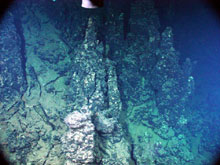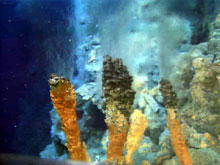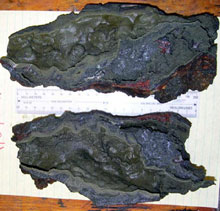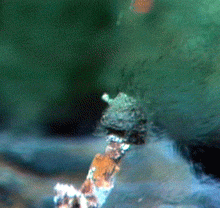
The steep slope of the East Diamante volcano is seen in this image from the upper left to the lower right-hand side. Large blocks of lava, denoted by the cracks, are covered by a thin layer of sediment. Click image for larger view and more details.
Hot Springs and Smoking Chimneys at East Diamante Volcano
April 6, 2004
Cornel E.J. de Ronde
Geologist
Institute of Geological & Nuclear Sciences (GNS)
Lower Hutt, New Zealand
![]() View a hydrothermal vent aptly named the “Five Towers” (mp4, 4.8 MB)
View a hydrothermal vent aptly named the “Five Towers” (mp4, 4.8 MB)
![]() See chimneys made of sulfide minerals at the Black Forest (mp4, 5.1 MB)
See chimneys made of sulfide minerals at the Black Forest (mp4, 5.1 MB)
Imagine what it would be like to walk up the side of a steep volcano, stumbling over rocks that ranged in size from small boulders to blocks the size of a car. Then, when you looked upslope, towering above you were "chimneys" the likes of which you had never seen. Some were long and straight like a telephone pole, others cone-shaped, and still others had tortured shapes that would not have looked out of place in a horror movie. That is what greeted us as we sat in the control room of the research vessel Thomas G. Thompson, peering at the images on our TV screens as we maneuvered the ROV (remotely operated vehicle) ROPOS over the sea floor. It was about 1:30 in the morning and we were surveying the top of East Diamante volcano.

Photograph of three small (~30-cm or 12-in tall) actively venting spires sitting on top of one of the chimneys in the Black Forest vent field. The chimneys themselves are about 7 m (23 ft) tall. The fluids here are venting at 240ºC and are expelling black (mineral-rich) smoke into the ocean. Click image for larger view.

A piece of one of the chimney spires, cut in half and lined by a copper-rich mineral called chalcopyrite. The gray- and-white zone near the exterior of the chimney is composed of iron, zinc and barium-rich minerals called pyrite, sphalerite and barite. Click image for larger view and more details.
What we found was a vent field, almost like a forest, of chimneys that thrust their way up from the rocky substrate as if they were reaching for the surface some 350 m (1,150 ft) above. Each one of these chimneys represents a place where hot, acidic, metal-rich fluids -- commonly referred to as hydrothermal fluids -- have risen through the volcano to be expelled onto the sea floor. When this hot (250°C, 480°F) fluid comes in contact and mixes with the surrounding cold (7°C, 45°F) seawater, a chemical reaction takes place in a most spectacular way. All the metals previously dissolved in the hydrothermal fluid now precipitate out and form thick clouds of metal-rich smoke; hence the oft-referred name of “black smokers." Most of the metal is gorged into the ocean as this black smoke, but a small percentage, perhaps 5 percent, is trapped within the metal-rich chimneys, ensuring that some of them grow tall and wide.

This is a small, ice-cream-cone-shaped chimney located near the base of Five Towers, which shows the affects of hydrothermal fluid boiling on the sea floor. Click image for larger view and more details
There are at least 50 chimneys in the area we named the “Black Forest." Most of the chimneys we saw were dead; that is, hot water had ceased to flow within them. Most were around 2 m tall but some stretched up to 9 m (almost 30 ft) off the sea floor. As we moved upslope amongst the chimneys, we were delighted to discover that some were very much alive. One group, aptly named “Five Towers," had a large base several meters in diameter with individual chimneys 7-9 m high that spewed black smoke into the surrounding seawater. We have never seen a field of chimneys like this in such shallow water. Finally, we witnessed a rarely seen phenomenon. We saw evidence of hot water boiling right at the exit point of one of these chimneys, where streams of droplets (gas) emanated from one part of the chimney while hot liquid escaped from a different part. We sampled the hot water, the gas, and pieces of the chimneys so that we might better understand how these magnificent underwater chimneys are formed.
Sign up for the Ocean Explorer E-mail Update List.



























